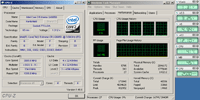Intel Core 2 Extreme QX6850
Vital Signs and Overclocking

Like all Core 2 Quad CPUs, the QX6850 runs a pair of Conroe dual-core processors under its heat spreader - the only difference is that its stock FSB speed is clocked at 1,333MHz. This processor runs a 9X multiplier and a 333MHz system bus speed that is then "quad-pumped" to its rated FSB of 1,333MHz.
CPU-Z shows a "B" stepping and a die revision of G0. Each dual-core die is equipped with 4MB of cache for a total of 8MB. The QX6850, like the QX6800, is also built on Intel's 65nm fab process. With four cores operating at 3GHz, this cutting-edge die geomtry is required for mitigating power consumption and heat, among other things.

Stock Operting Temp - No Load
Full 3GHz Clock Speed

Stock Operating Temp - 100% Load
In the above screen shots you can see we've tested the QX6850 under both idle and full-load conditions. However, we disabled Intel's Advanced Speedstep technology in the BIOS of the motherboard, to show you temperatures at idle but also at full clock speed. At 41°C and at a full 3GHz, the QX6850 is cool and comfortable. At full load, temperatures scale up to 56°C but that's pretty impressive actually, since there are four CPU cores under the hood running at 3GHz. To think Intels old Prescott Pentium 4 single-core CPUs reach 60°C under load... How far we have come, Intel.

Stock Operating Temp - No Load
With Speedstep
Finally, with Intel's Speedstep technology enabled, at idle the core drops its voltage to 1.1V and clock speed to 2GHz. This allows the core even lower temperatures, reported here at 21°C.
|
|
|
And of course, since Intel has come this far, we just had to see if we could take things up a notch or two more. Our overclocking efforts are pictured below. Needless to say, we were rather impressed.

Core 2 Quad QX6850 @ 3.73GHz
100% Load, Stable
It took a small voltage bump to 1.45V in the BIOS to hit 3.73GHz. To achieve this, we raised the FSB to 466MHz and dropped the multiplier to X8. Once we hit our highest, stable clock speed, we were surprised how stable things were even with a relatively low cost standard HSF cooler. We used an Artic Cooling Freezer 7 to achieve these results. Temperatures under full load were getting a little toasty though, at 69°C. With more exotic cooling, or water, the QX6850 most likely would top out even faster. That said, even with a stock retail heatsink and fan assembly, 3.4 - 3.6GHz is most likely a walk in the park for many QX6850 chips. Is Intel holding back? Probably, because they can.








